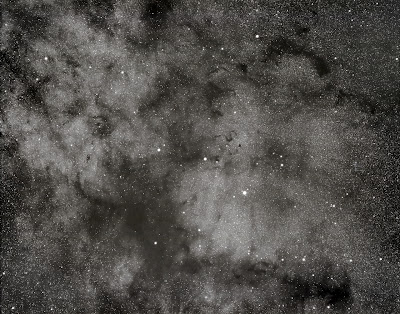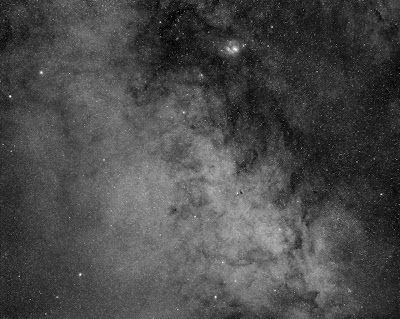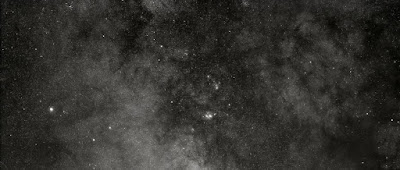An observing report from this morning. Images are from my archives.
Enjoy!
May 19, 2018
1:15 AM – 2:45 AM
Skies clear with above average
transparency. Limiting magnitude 7.0 + SQM 21.7 MPSAS
Milky Way vivid even on the south
horizon. The dark nebulae in southern Ophiuchus obvious to the
unaided eye. Spectacular conditions compared to previous observing
sessions this spring.
I had setup the tripod the previous
evening, gotup at 1:00 AM and set the binocular. I used the BT-100
with 18mm UF (31X @ 2.1º) and
began observing the area of Antares. Enjoyed the beautiful triplet
star Rho-Oph. Looking southward, Antares, Messier 4 and NGC-6144 fit
neatly inside the eyepiece field. Messier 4 was resolved with the
prominent bar noted. Panning east from this region the dark streamer
Barnard 44 continued for several fields, then I continued to the
wonderful chain of stars stemming northward from Theta Ophiuchi.
This asterism appears to be unnamed. It begins with Theta and gently
arcs northward with proceedingly fainter stars.
 |
| The Dark Streamers East of The Antares Region |
Slightly
north and east of Theta Oph is 44 Ophiuchi. This is the springboard
of the somewhat faint but rich area of Milky Way strata littered with
dark nebulae. It includes the famous Barnard 72, the Snake Nebula. I
have attempted this dark nebula before, but under less than favorable
conditions. During the early morning I returned to this area as it
came to culmination. I'm happy to report that it was well seen.
Even the small round B68 was visible just to its south. Barnard 261
to the northeast was also visible in field. Barnard 72 revealed its
coil only with averted vision at first until I learned the area.
Somewhat higher power may be a better combination to behold it. This
was a bucket list object and I'm tickled to have seen it, especially
in such a wide-field view!
 |
| The Region Of Southern Ophiuchus |
Panning
this area, countless dark nebulae are seen and it would have been
overwhelming to try to account for them all. Panning southward and
entering the Pipe Nebula, LDN1773, I hovered over the sixth magnitude
star HIP 85783, located within the bowl of the Pipe. Even with a two
degree field the field held only a few members and was practically
starless. A lonely field in such a rich part of the sky.
Panning
eastward and into the Great Rift one cannot be prepared for what is
perhaps the greatest Milky Way sweep in the entire sky. Approaching
the dark estuaries of the Great Sagittarius Star Cloud is a
existential experience. Under dark and transparent skies,
approaching this area is surreal. This is one of the grandest views
in all the sky, yet few seem to have experienced it.
 |
| The Great Star Cloud of Sagittarius |
The
dark voids and shoals of the Great Star Cloud appear abruptly from
the west. Panning along the cloud's jagged perimeter, which runs
along the Galactic Equator from Messier 8 and southward to the area
encompassing Messier 6 and 7, amounts to the brightest deep sky tour
in all the Milky Way. To truly appreciate however, dark transparent
skies are a must.
While
the west side of the Great Cloud offers the most dramatic view, the
central interior of the cloud is also rich in a dark tapestry. In an
area extending south from 11 Sagittarii (just east of Messier 8) to
Gamma Sagittarii, the area is strewn with dark features layered over
the brilliant star cloud. Barnard 90 stand out as one prominent
example of these dark objects seen against the brighter stellar
stratum.
To
the north of this region is Sagittarius' lesser cloud. The Small
Sagitarius Star Cloud, Messier 24, is a wonderful object adorned with
a surplus of dark nebulae, star chains and neighboring clusters.
Along with the Scutum Star Cloud and the Great Cloud of Sagittarius,
Messier 24 and its denizens rank as the finest in the sky. In the 2º
field, M24 is a delight. Brilliant stars compose the major cloud and
small dark nebulae, such as B92 and B93, on its northern edge provide
stark contrast to the view. Other dark nebulae such as Barnard 304
appeared along the northern section, stemming from near B92 and
meandering southwestward. Also, other dark features, such as “The
Forks” on the east side of the cloud. Within the cloud, the tight
open cluster NGC-6603 stood out plainly and showed partial
resolution.
 |
| The Small Sagittarius Star Cloud Region |
The
southern side of messier 24 is dark and the southwest end of the
cloud transitions into what I call, “The Blade”. The dark region
makes a right angled appearance to the “edge” of this knife-like
feature.
The
emission nebulae IC1284 resides in this same dark region south of
M24. The two stars just west of IC1284 exhibit reflection nebulae,
these are VDB 118 and VDB 119. VDB 119 was seen with an obvious
condensation.
West
of M24, Messier 23 is a grand open cluster with bright members. To
it's north Barnard 84a is a vertical black tadpole with a solitary
~10th
magnitude star superimposed. North of M24, Messier 17 is a grand
view. The swan appearance is plain, but also the outer loop seen in
long exposures is evident with direct vision.
North
and east of M24 is a curious object, Barnard 312. This object is
perhaps most impressive because contrast and delineation is very
high. Visually this object surpasses the photographs I have made, or
have seen. The soft glow of the stratum north of this object appears
to glow, in part due to the immediate darkness of the nimbus. An
interesting object and was always interested in it after finding in
my photographs of the Milky Way about ten years ago.
 |
| Messier 8 Region |
The
Lagoon Nebula, Messier 8 as seen in the BT-100 is well seen. The
bright hourglass feature, along with the bright open cluster NGC-6530
and the fainter periphery of nebulae are all encompassed in the 2º
field. The view is incredible. The binocular reveals stunning
contrast of this scene and it scarcely seems real. Also visible in
the field is the globular 6544 and to its south, NGC-6553. Lots of
subtle detail wherever you look, some on atlases, some are not.
Seeing deeply into this area of the galaxy is a joy.
 |
| Binocular Astronomy Under The Dark Skies of Downeast Maine |
Jim - and incredible tribute to film and your craft.
ReplyDeleteThank you. Investigations photographically and visually have been their own reward in a lifelong pursuit of seeing. Fortunate and happy to be here.
Delete